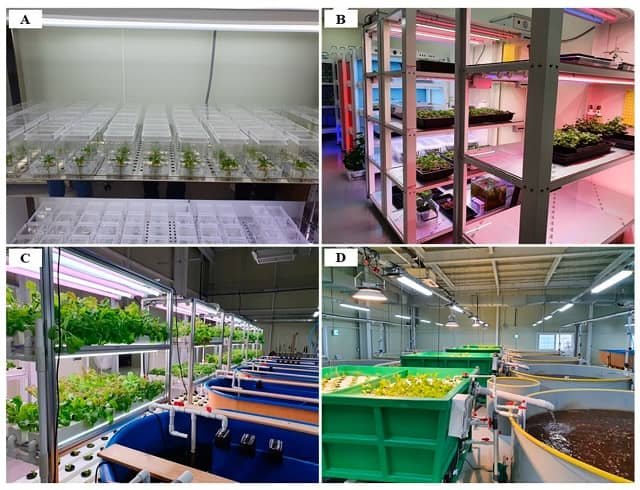
Traditional aquaculture has been a vital source of food but has faced challenges in terms of environmental impact, including pollution and disease outbreaks in cultivated organisms. In response to these challenges, an innovative technology called Biofloc Technology (BFT) has emerged, promising to revolutionize the aquaculture industry. However, BFT has some disadvantages, such as rapid changes in water quality due to the accumulation of dissolved nutrients and total suspended solids.
Nevertheless, BFT technology can enhance its value and efficiency by combining with other aquaculture technologies, such as aquaponics and vertical aquaculture, to overcome these disadvantages.
A scientific review published by researchers from Pukyong National University, Sun Moon University, Korea Institute of Marine Science & Technology Promotion, National Institute of Fisheries Science, Kunsan National University, Korea Maritime and Ocean University, National Institute of Fisheries Science, and Jeju National University discusses the positive aspects of converging BFT technology with aquaponics and vertical aquaculture.
Benefits of Biofloc Technology (BFT)
One of the main advantages of BFT is its ability to improve water quality without the need for water exchange, which helps reduce pollution. This is achieved by efficiently removing ammonia produced by aquaculture organisms. Furthermore, BFT has the potential to increase production sustainably while minimizing disease spread compared to traditional systems. This makes it an attractive option for environmentally responsible aquaculture.
Aquaponics and Biofloc
Aquaponics, which combines aquaculture with plant cultivation in a symbiotic system, can utilize nutrients from BFT wastewater for plant growth, increasing the overall system efficiency and reducing waste. According to the researchers, BFT can result in high nutrient content in effluents due to low water exchange rates and high stocking densities. To address this issue, they highlight that water reuse or nutrient recycling in aquaponic systems can be considered.
The integration of aquaponics with BFT was named “FLOCponics” and introduced a new type of aquaponics system that replaces recirculating aquaculture systems with the biofloc system. This integrated system has the potential to increase economic diversity by producing vegetables and mitigate nitrate and phosphate accumulation in the biofloc system management.
“The research on an integrated BFT and aquaponics system is currently in its initial phase with a limited number of published articles and a lack of standardization in system design and experimental methodologies. Several factors need to be considered for the sustainability and optimization of this system,” emphasized the study authors.
Vertical Aquaculture and Biofloc
On the other hand, vertical aquaculture, which involves fish production in vertically stacked structures, can make the most of limited space and reduce the need for extensive land, thus eliminating geographical limitations and accelerating the urbanization of aquaculture. Vertical aquaculture is an innovative system developed by Professor Dickson Despomeer of Columbia University in 1999. This aquaculture production system can operate in multiple stages using raceway systems.
“The vertical aquaculture technology, which has potential through its various advantages, should be integrated with the biofloc system, which can actively manage waste using effective microorganisms to break down fish waste without the need for separate facilities,” emphasize the scientists.
However, the researchers warn that there is currently no research on the integrated biofloc and vertical aquaculture system. In this regard, it is necessary to establish indicators and limitations through the design of standardized integrated systems.
Conclusion
In summary, Biofloc Technology (BFT) emerges as an innovative solution to address the challenges of traditional aquaculture. Although it has disadvantages such as nutrient accumulation and the need for expensive equipment, integrating BFT with other Fourth Industrial Revolution technologies and approaches promises a bright future for sustainable and efficient aquaculture.
“Aquaponics and vertical aquaculture are advantageous for urban environments due to their spatial efficiency and potential to mitigate environmental issues. Furthermore, when these two technologies are combined with BFT, they may compensate for BFT deficiencies. The fusion of BFT with aquaponics and vertical aquaculture is expected to provide innovative solutions to the challenges facing the aquaculture industry,” conclude the scientists.
This combination of methods can not only enhance production and water quality but also accelerate the urbanization of aquaculture and eliminate geographical restrictions, essential for ensuring a sustainable supply of aquatic food in a constantly growing world.
The study was funded by the National Institute of Fisheries Science.
Reference (open access)
Yu, Y.-B.; Choi, J.-H.; Lee, J.-H.; Jo, A.-H.; Han, S.W.; Han, S.-H.; Choi, H.J.; Choi, C.Y.; Kang, J.-C.; Min, E.; et al. Biofloc Application Using Aquaponics and Vertical Aquaculture Technology in Aquaculture: Review. Fishes 2023, 8, 543. https://doi.org/10.3390/fishes8110543
Editor at the digital magazine AquaHoy. He holds a degree in Aquaculture Biology from the National University of Santa (UNS) and a Master’s degree in Science and Innovation Management from the Polytechnic University of Valencia, with postgraduate diplomas in Business Innovation and Innovation Management. He possesses extensive experience in the aquaculture and fisheries sector, having led the Fisheries Innovation Unit of the National Program for Innovation in Fisheries and Aquaculture (PNIPA). He has served as a senior consultant in technology watch, an innovation project formulator and advisor, and a lecturer at UNS. He is a member of the Peruvian College of Biologists and was recognized by the World Aquaculture Society (WAS) in 2016 for his contribution to aquaculture.
